This article is all about sharing practical extinction examples that parents can use in ABA therapy for effective behavior management. It highlights how important it is to consistently apply personalized extinction strategies—like ignoring those attention-seeking tantrums or reinforcing alternative behaviors. These approaches are crucial for reducing those pesky undesirable actions and promoting positive behavioral changes in children with autism.
Let’s dive into this together! By focusing on what works best for your child, you can make a real difference. Remember, every small step counts, and we're here to support you in navigating this journey. Your experiences matter, and sharing them can help create a sense of community. So, let’s explore these strategies and see how they can fit into your parenting toolkit!
Understanding the intricacies of behavior management can feel overwhelming for parents, especially when navigating the complexities of Applied Behavior Analysis (ABA) therapy. One key concept is extinction—essentially, it’s about reducing undesired behaviors by withholding reinforcement. This powerful tool can truly make a difference on your journey! 😊
In this article, we’ll explore seven practical extinction examples that you can implement at home. These strategies can help foster positive behavioral changes in children with autism.
But what happens when these techniques lead to an initial spike in unwanted behaviors, known as an extinction burst? This can be quite a challenge for caregivers, highlighting the importance of consistency and collaboration in achieving effective outcomes.
Let’s explore this together!
At Rori Care, we believe that tailored strategies are at the heart of effective ABA therapy. Our dedicated practitioners conduct thorough assessments to identify specific behaviors that may need adjustment. By using functional conduct analysis, we create personalized extinction example ABA strategies that address each child's unique needs. This individualized approach not only enhances the effectiveness of our management techniques but also leads to significantly better outcomes in their therapy journey.
We understand that navigating this process can be challenging for parents. That's why our behavior care engine generates automatic progress reports for clinician evaluation, ensuring caregivers have the data and insights they need to support their child's behavioral goals. Recent research shows that personalized interventions are crucial for fostering meaningful behavioral changes. This makes our tailored extinction example ABA techniques a vital part of effective autism care.
By maximizing therapy outcomes, Rori Care is here to empower families, ensuring that every child receives the best possible care. Let’s explore this journey together! We’re here to help you every step of the way!
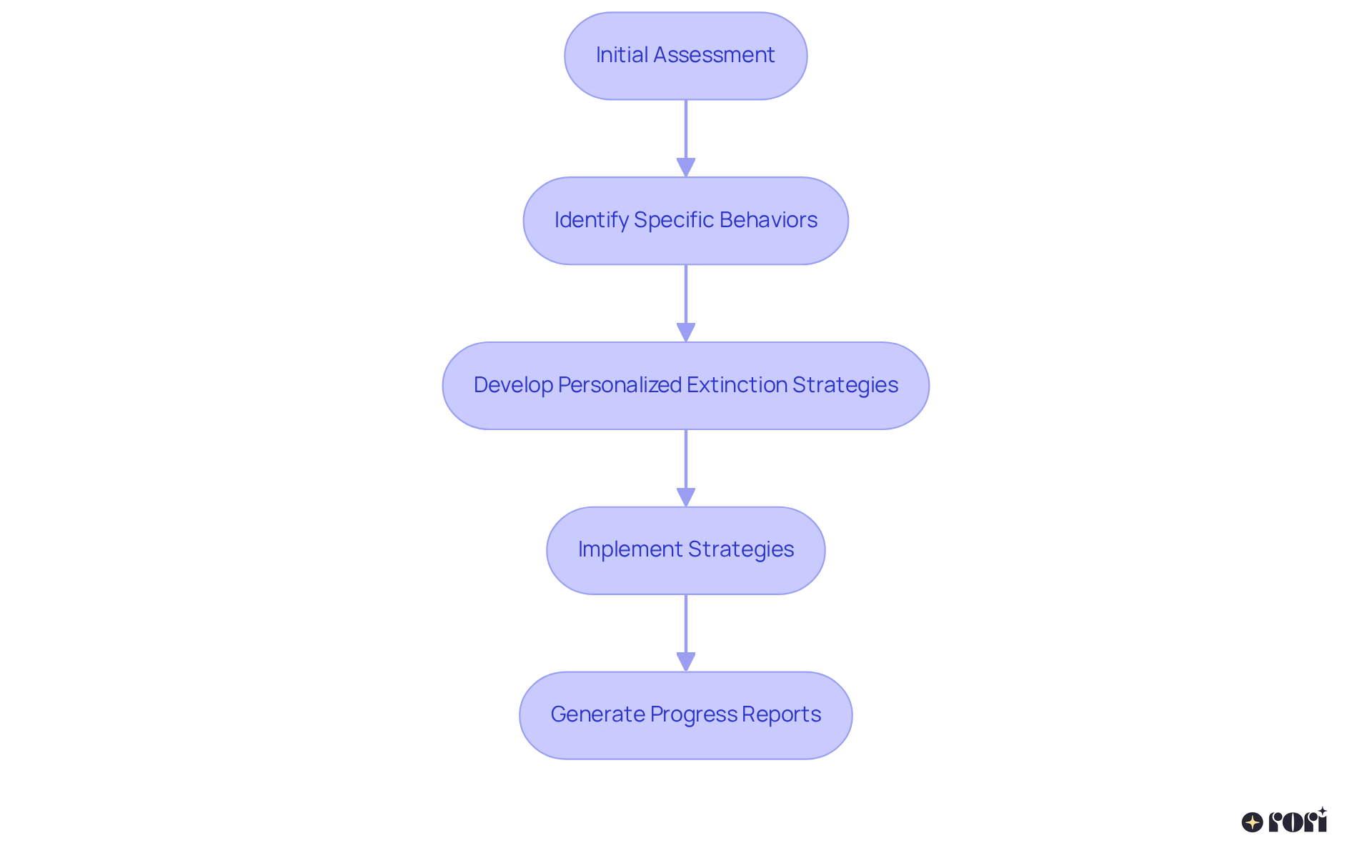
An extinction example aba in therapy is an important process aimed at reducing or eliminating behaviors by withholding the reinforcement that once supported them. This understanding is vital for both parents and practitioners, as it equips them with the tools needed to manage challenging behaviors effectively. Recognizing the importance of loss allows caregivers to implement strategies that not only promote positive changes but also encourage independence in children with autism.
Here are some effective extinction strategies to consider:
Understanding the extinction example aba is particularly important for addressing challenging behaviors in children with autism. By effectively implementing extinction techniques, caregivers can create an environment that nurtures positive behavior change, ultimately enhancing the child’s ability to thrive and acquire essential life skills. To further support this journey, it’s beneficial to maintain regular communication with qualified analysts to ensure that interventions remain effective and responsive to your child's changing needs.
A practical tip for caregivers is to keep a log to track progress and identify trends. This can aid in informed decision-making and improve the overall effectiveness of the strategies used. Let’s explore this together! We're here to help you every step of the way!
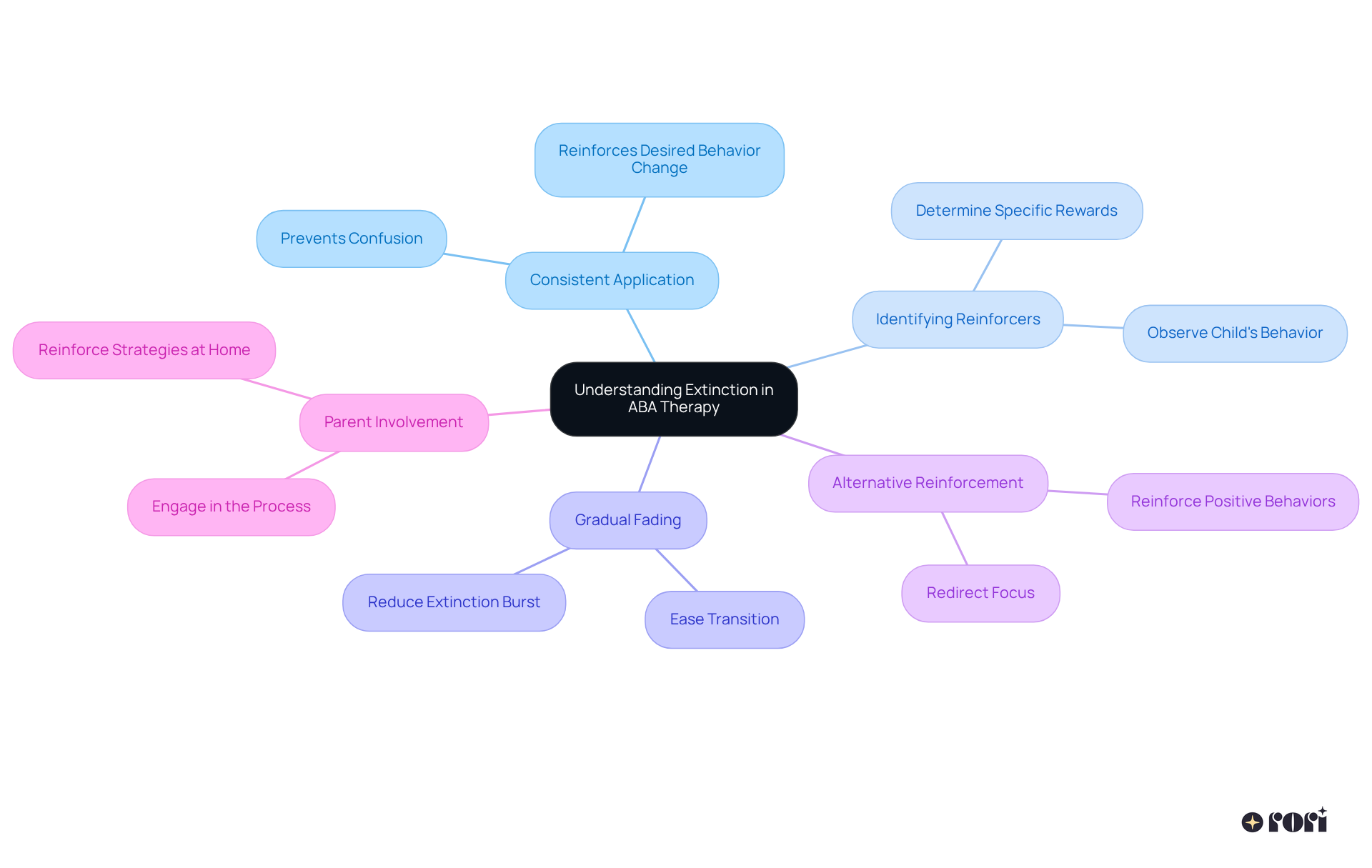
Here are some practical extinction examples that you, as parents, can easily implement in your daily interactions, all backed by Rori Care's approach to functional behavior analysis and the principles of early intensive behavioral intervention (EIBI):
When your little one throws a tantrum to grab attention, consider ignoring the behavior. By withholding attention, you can gradually reduce the frequency of these outbursts. Just a heads up—this might lead to an initial increase in tantrums, known as an extinction burst, before things start to improve.
If your child is shouting for a toy, try taking it away until they use appropriate language. This strategy encourages them to communicate better to get what they want.
For those kids who seek attention by interrupting conversations, praise them when they wait patiently instead of responding to the interruptions. Consistency is key here—it will help reduce those interruptions over time.
If your child is used to getting a reward, like a candy bar, consider swapping it for a healthier option, such as a fruit snack, when they ask for the candy. This not only helps minimize tantrums related to the candy’s removal but also promotes healthier choices.
If your child frequently requests a specific game during study time, set a rule that the game is only available after homework is done. This approach helps them prioritize tasks while reducing the need for instant gratification.
When your little one displays aggressive behaviors like hitting or kicking, calmly remove them from the situation and discuss alternative ways to express frustration. This method helps them understand that aggressive actions won’t lead to the desired outcome.
Lastly, visual aids like a chart showing expected behaviors and outcomes can help your child understand what’s required of them, easing anxiety and reducing the chances of emotional outbursts.
These examples provide an extinction example aba, illustrating how extinction techniques can be effectively woven into daily life, encouraging positive behavior changes and enhancing communication skills in children with autism. Plus, conducting a Functional Behavior Assessment (FBA) can help you understand the reasons behind your child's actions, allowing for more tailored interventions. Rori Care's conduct care engine can assist in analyzing these behaviors and generating automatic progress reports for clinician review, ensuring you have the support you need. Remember, consistency is essential when applying these techniques to effectively manage behaviors. Let’s explore this together!
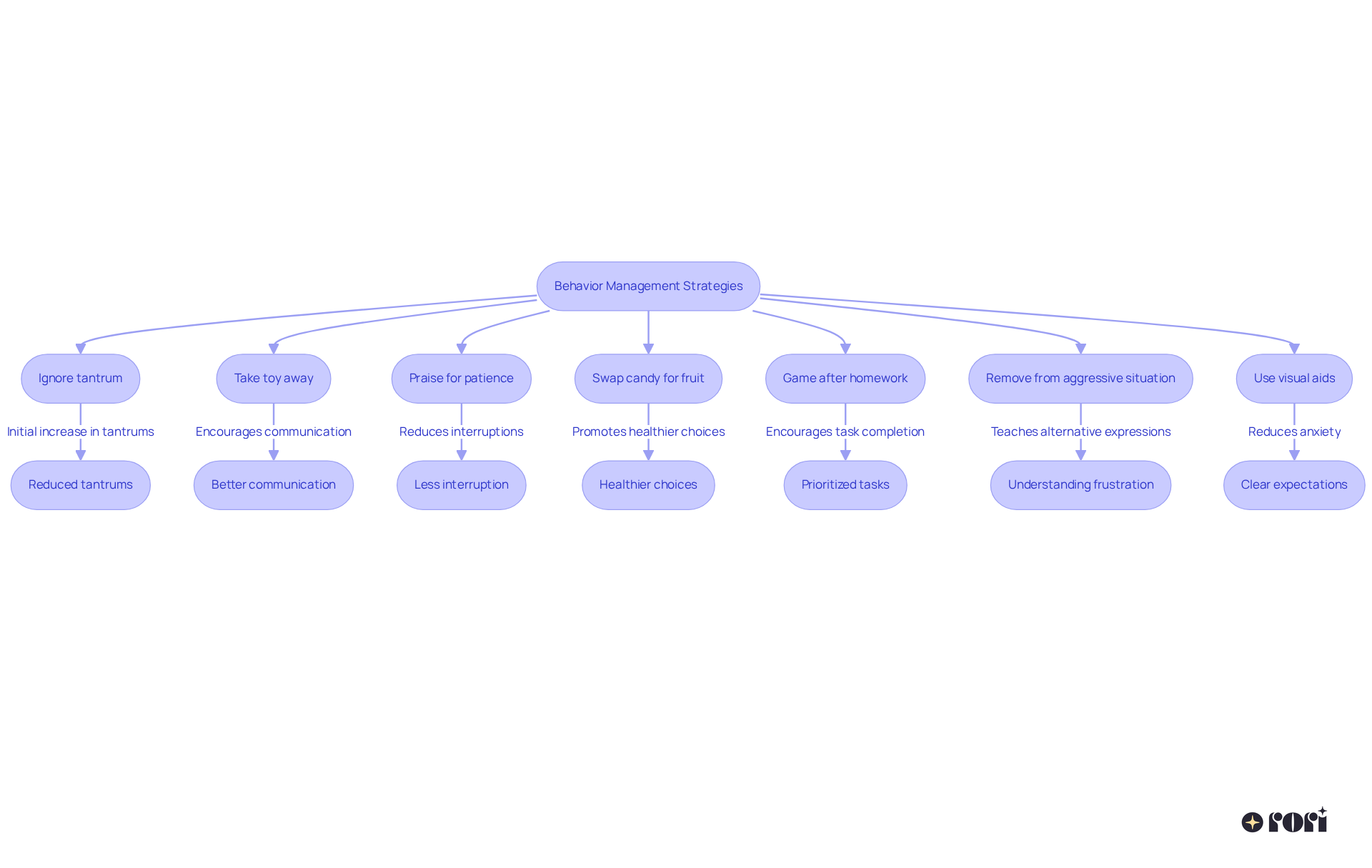
Parents often encounter something called escalation bursts, where unwanted behaviors might spike before they start to decrease. This can be quite challenging! In fact, recent studies show that nearly half of the cases involved either behavioral surges or increased aggression during treatment. To navigate these tricky moments, it’s essential to stay consistent with behavior reduction strategies. Caregivers should apply the same techniques at home that are used in therapy settings.
Educating caregivers is key here. It gives them a better grasp of ABA principles, which helps them make informed choices that can positively impact their child's progress. It’s also really important to consider how the child is feeling during the removal process. If things aren't handled with care, anxiety or frustration might increase. Open communication with families about the possibility of extinction example ABA bursts and how to manage them is crucial for effective implementation.
By working together and setting clear, measurable goals, practitioners can ensure that everyone is on the same page when it comes to reinforcing desired behaviors. This teamwork not only supports the child’s growth but also empowers caregivers, reducing stress and improving family dynamics. Let’s explore this together and create a supportive environment for our kids!
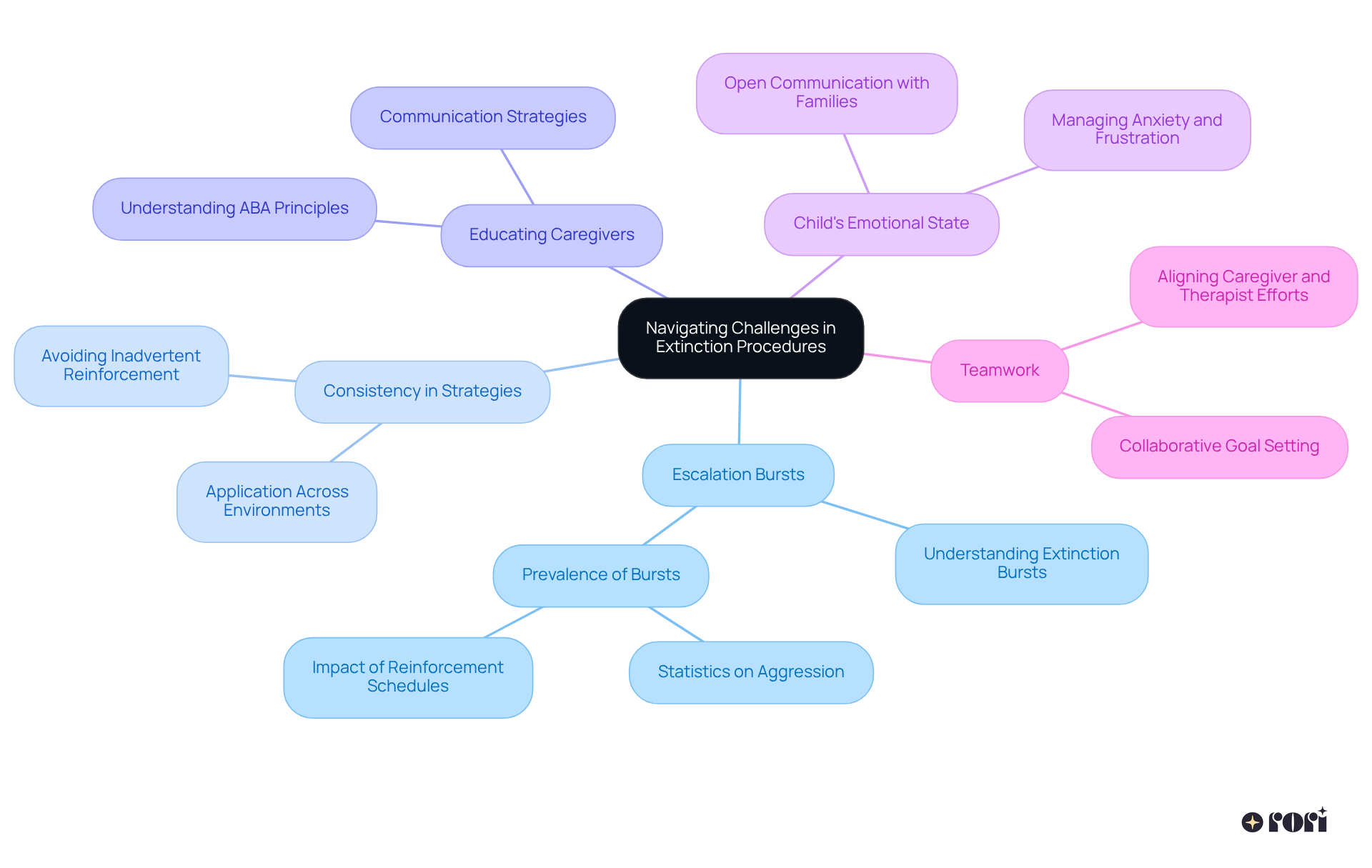
When applying extinction example ABA techniques, it is crucial for practitioners to adhere to ethical guidelines that prioritize the well-being of the individual and involve caregivers in the journey. This means ensuring that the young one isn't subjected to unnecessary distress, while also keeping parents informed and actively engaged in the therapy. By empowering caregivers with ABA principles and strategies, they can provide even better support at home, complementing professional interventions and promoting consistency.
This active engagement often leads to improved behavioral outcomes and boosts caregivers' confidence in their ability to support their little ones. Plus, practitioners should consider the long-term effects of disappearance on the young one's emotional and social development, striving to create a nurturing environment throughout the therapy. This collaborative approach not only fosters informed decision-making but also enhances the overall effectiveness of behavioral interventions.
Caregivers are encouraged to regularly communicate with practitioners, monitor their child's progress, and consistently implement the techniques they've learned at home. Let’s explore this together! We’re here to help you every step of the way!
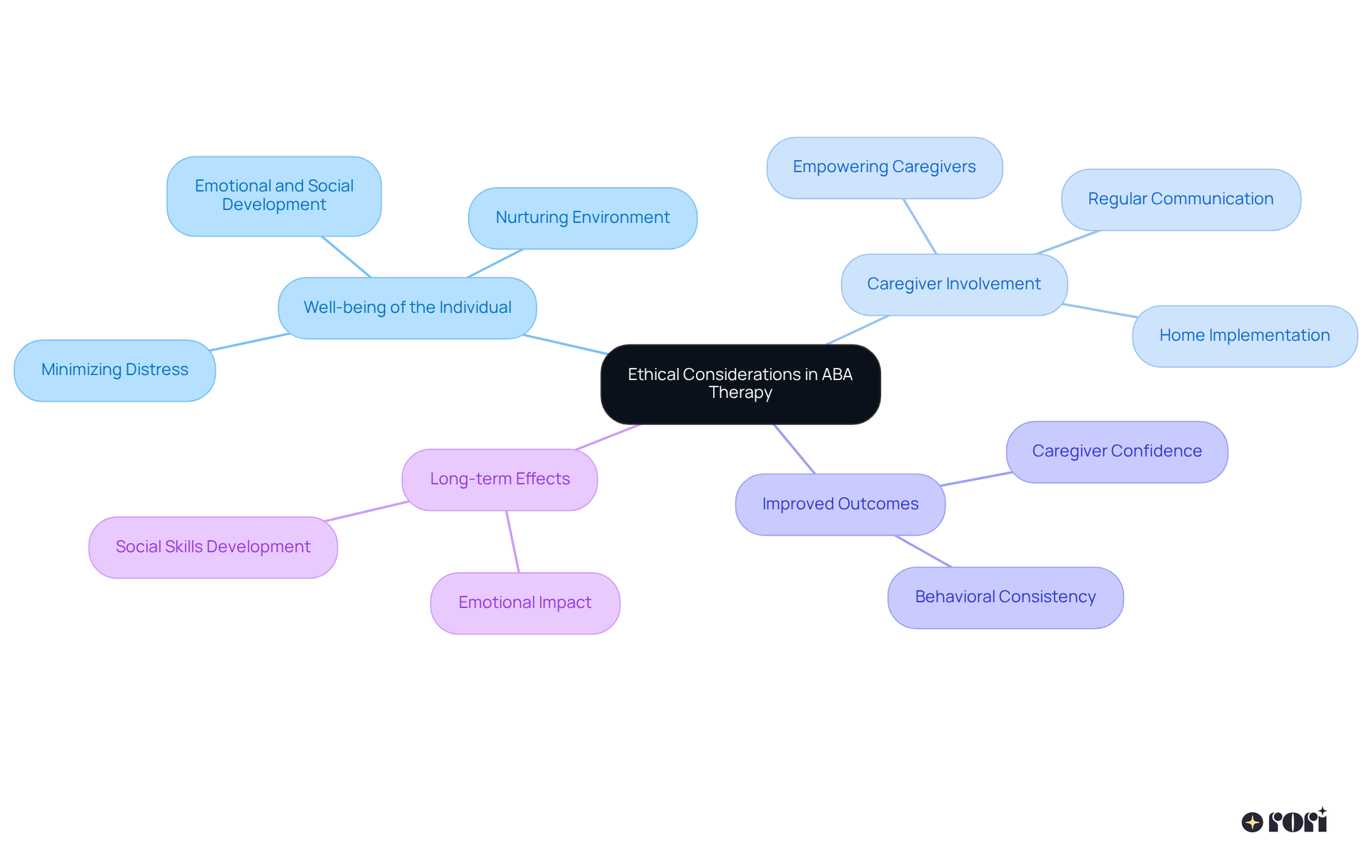
Successful execution of elimination procedures really hinges on keeping a close eye on the individual's progress. This ongoing observation is such a vital part of Rori Care's personalized planning strategy! Practitioners need to regularly check in on how often and how intensely the target actions occur. This allows for quick adjustments to the extinction example aba—consider tweaking the reinforcement schedule or adding support strategies that fit the child's unique needs.
Our conduct care engine is designed to update intervention and skill acquisition plans after each session based on the progress made. This reinforces how important measurable goals are for tracking frequency and intensity. Having a structured data collection plan is key; it helps reveal patterns that inform necessary changes and ensures the intervention stays effective.
It's also important to recognize that there might be a burst of undesirable actions at first. Sometimes, unwanted behavior can temporarily spike before it starts to fade away. By promoting understanding and teaching alternative actions while reducing undesired responses, we can really help the young person succeed in changing their behavior.
Of course, ethical considerations are a top priority to ensure the child's well-being throughout this process. By keeping a flexible approach and regularly reviewing the intervention plan, caregivers can create a nurturing environment that fosters positive behavioral change. Plus, equipping caregivers with ABA principles and encouraging collaboration between caregivers and skilled behavior analysts is essential for making the intervention effective.
Let’s explore this together! We're here to help you every step of the way!
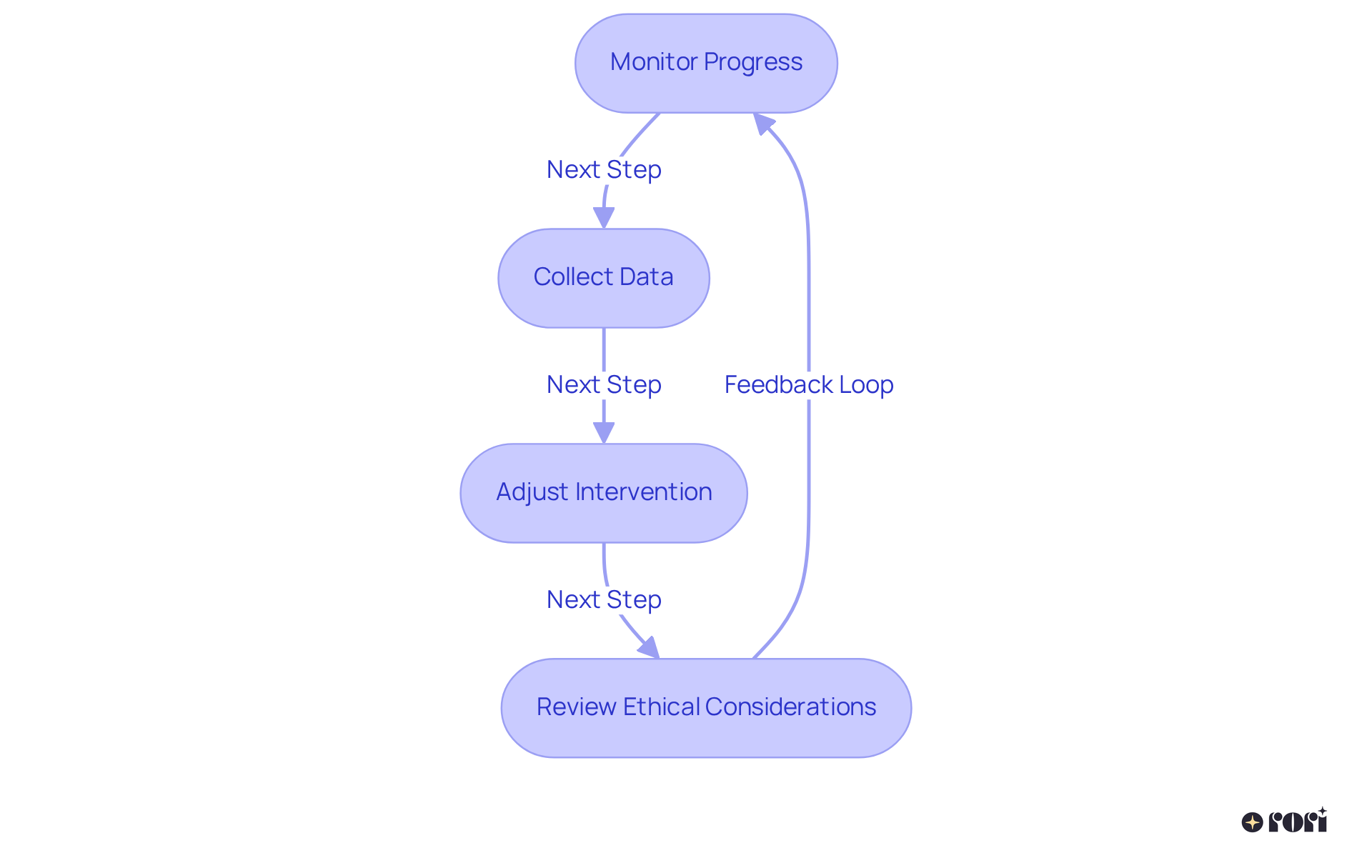
Working alongside professionals like speech and occupational therapists can greatly improve the effectiveness of the extinction example ABA techniques in ABA therapy. At Rori Care, we’re here to support your family's journey by blending insights and strategies into cohesive treatment plans that cater to each individual's unique needs. Our dedicated clinicians emphasize the importance of regular team meetings and open communication with families. This way, everyone stays on the same page when it comes to managing behavior.
Did you know that studies show interdisciplinary approaches can lead to better outcomes? In fact, there’s been a notable 9.7% increase in goal success rates after integrating hybrid therapy models. Plus, 76% of patients have multiple goals trending upward thanks to these collaborative efforts! This teamwork not only enriches the therapeutic experience but also fosters a nurturing environment where young individuals can truly thrive.
As parents, you can play a vital role in this collaboration by actively participating in team meetings and sharing your insights about your child’s behavior and progress. By doing so, you empower yourself with ABA principles that support your children's developmental goals. Let’s explore this together—we’re here to help you every step of the way!
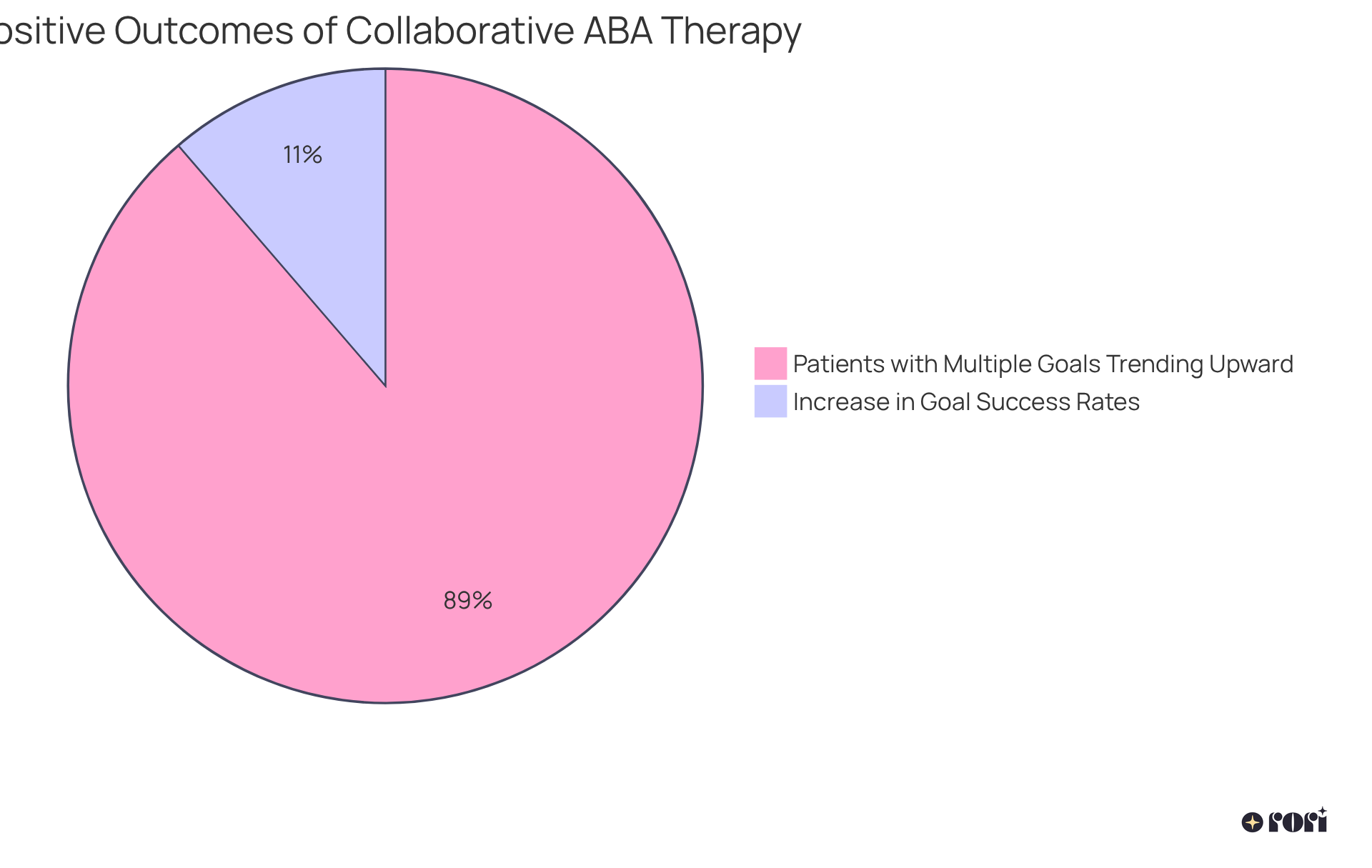
When it comes to managing extinction example aba bursts, it's crucial for practitioners to maintain a calm and consistent demeanor. This approach really helps kids see that heightened actions, like tantrums, won’t get them the reinforcement they’re hoping for, which is an extinction example aba. By focusing on strengthening alternative behaviors that are more appropriate, we can implement an extinction example aba to significantly reduce those challenging behaviors. For example, teaching children to express their needs through functional communication serves as an extinction example aba, which can help them rely less on problematic behaviors.
Research shows that 62% of individuals with moderate to profound intellectual disabilities displayed increased behavior during therapy when reinforcement was removed alone. This highlights just how crucial effective management strategies are. Additionally, we see that termination bursts occur in clinical samples about 24% of the time. Providing support during these tough moments is essential. Practitioners should clearly communicate with parents about what to expect during extinction example aba bursts and how to respond effectively. This cohesive approach ensures that plans are consistently applied both at home and in therapy, creating a supportive environment for the child.
By equipping caregivers with the knowledge and skills they need to support their child’s behavioral goals, Rori Care - ABA Therapy empowers families to make informed decisions and actively engage in their child’s development. As Ruben Kesherim wisely states, "Master ABA techniques for your child's autism therapy - calm, consistent, and confident." To boost effectiveness even further, caregivers should focus on collecting data to monitor progress and adjust strategies as necessary. This empowerment is key to improving behavioral outcomes and reducing stress within the family dynamic. Let’s explore this together!

At Rori Care, we understand the challenges parents face when it comes to ABA therapy. That's why our AI-powered technologies are here to help! These innovative tools provide an extinction example aba by facilitating the application of extinction techniques through automatic data collection during clinical sessions. Plus, we ensure that sensitive information is stored securely and anonymized.
Imagine freeing up 50% more time for your child's treatment! With automatic progress reports, practitioners can focus on what really matters—delivering personalized care. For example, frequency and duration recording methods allow therapists to see how often and how long specific behaviors occur. This insight helps in crafting targeted interventions that truly make a difference.
By using these advanced technologies, practitioners can make informed choices that enhance the effectiveness of extinction example aba approaches. This data-driven method not only improves the accuracy of interventions but also leads to better outcomes for youth with autism, supporting their growth and independence.
Each child receives a personalized treatment plan created by certified behavior analysts. These plans include measurable objectives and evidence-based approaches tailored to meet each individual's unique needs. The goal? To improve adaptive behaviors and foster greater independence!
And the best part? Continuous assessment and adjustment of these plans ensure they remain responsive to your child's changing needs. So, let’s explore this together! We’re here to help you every step of the way!
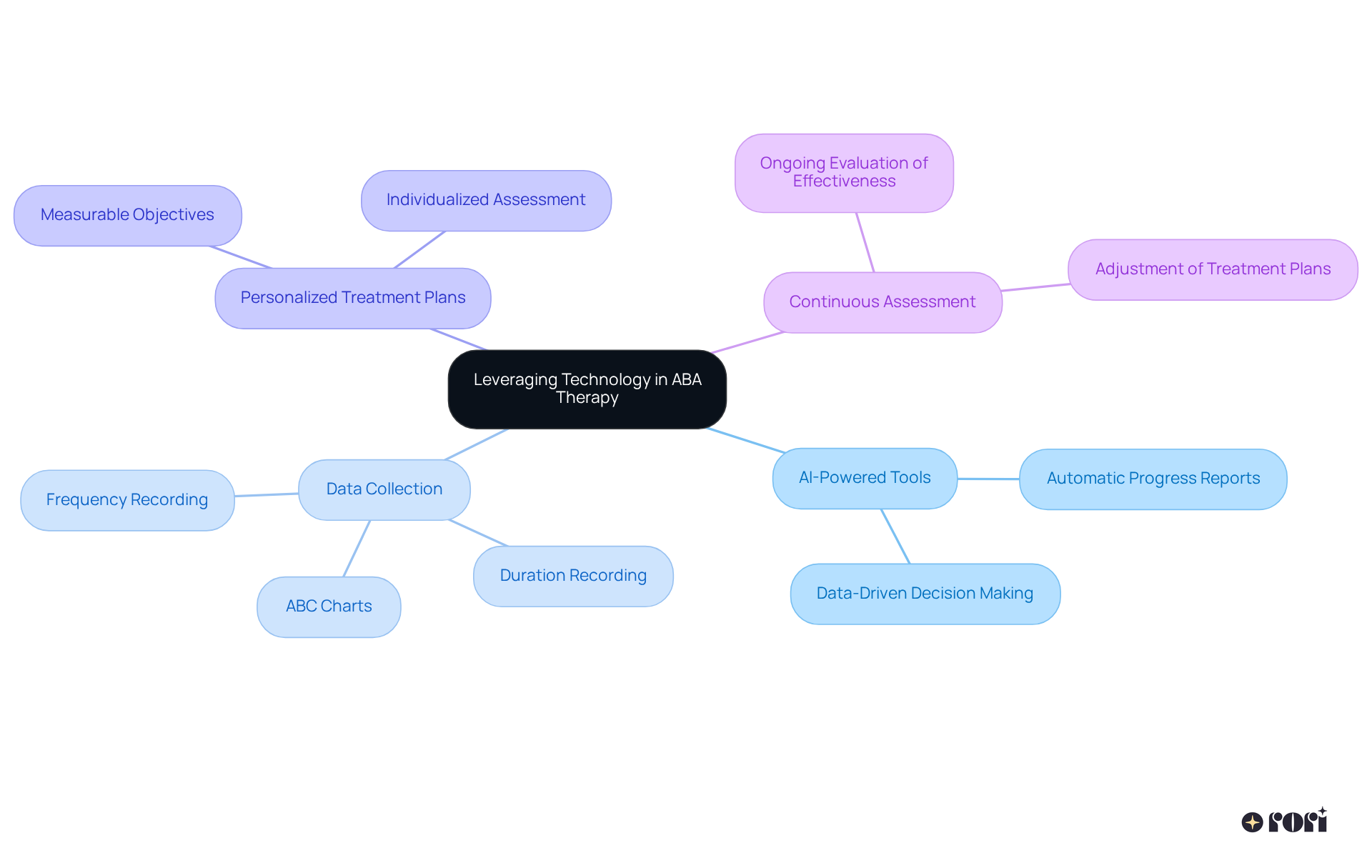
In summary, applying reduction techniques in ABA therapy effectively means using personalized strategies, ongoing monitoring, ethical considerations, and teamwork among professionals. At Rori Care, we totally get that facing a new diagnosis can be tough for families. That’s why we offer a free consultation to help create tailored developmental plans led by our caring experts.
By leveraging technology, like our AI-driven progress report automation, we boost the efficiency of ABA therapy, freeing up 50% more time for your dependent's treatment. This significant time-saving allows practitioners to focus more on individualized care.
By understanding the dynamics of extinction example aba and utilizing these innovative tools, practitioners can improve their approach to behavior management. Ultimately, this supports children with autism in reaching their full potential. Let’s explore this together!
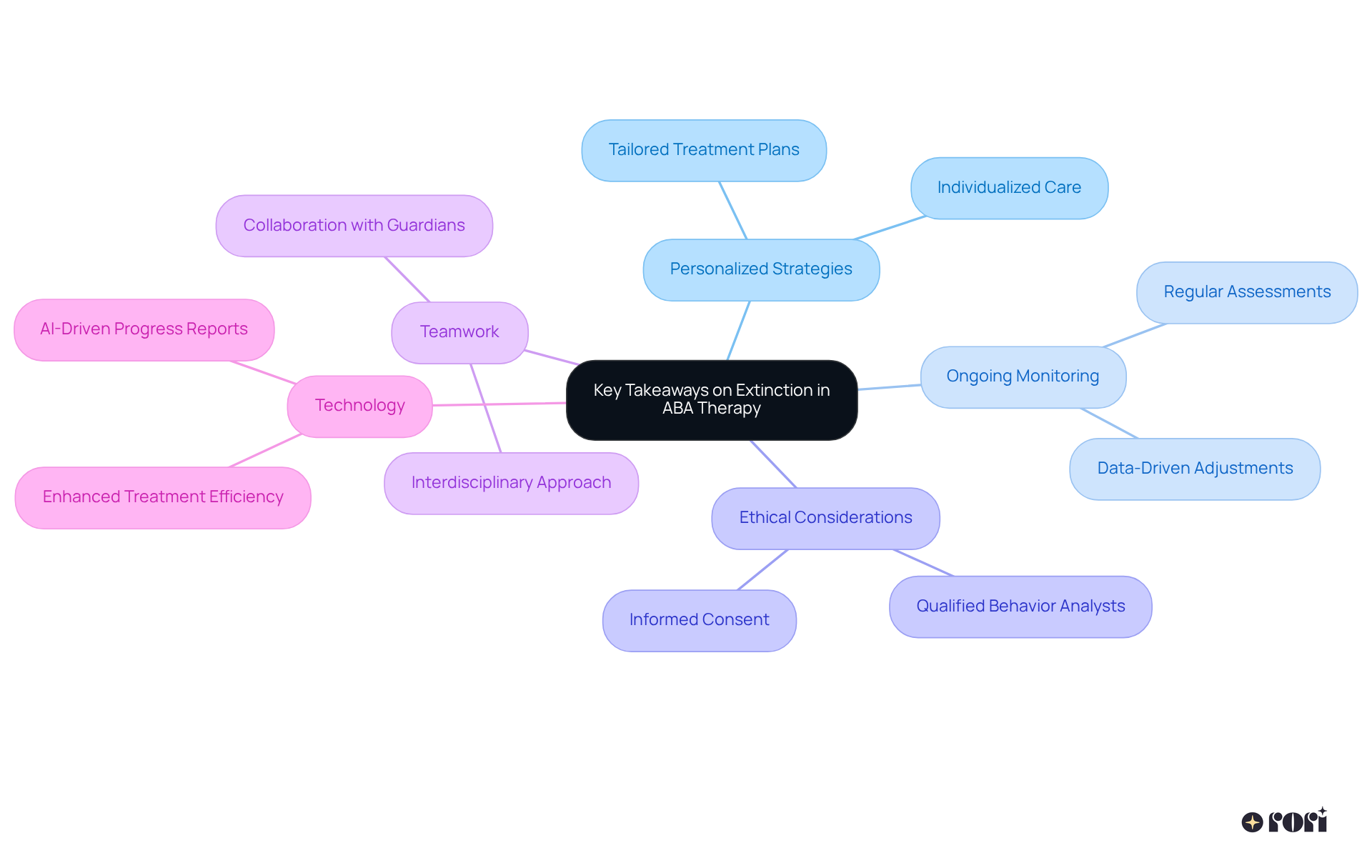
Understanding and implementing extinction techniques in ABA therapy can truly enhance behavior management for children with autism. By focusing on personalized strategies, consistent application, and active parental involvement, caregivers can effectively reduce undesired behaviors while nurturing positive changes. This tailored approach not only empowers families but also fosters a supportive environment that encourages growth and development.
Throughout this journey, we've highlighted key strategies that can make a difference. Think about the importance of identifying reinforcers, gradually fading reinforcement, and collaborating with professionals. These insights emphasize how vital it is for caregivers to stay engaged and informed, ensuring that interventions are consistent at home and in therapy sessions. Regular monitoring and adjustments based on progress are essential to navigating challenges, like those pesky extinction bursts.
Ultimately, behavior management through ABA therapy is a collaborative effort that calls for patience, understanding, and commitment. By embracing technology and fostering open communication with practitioners, families can enhance the effectiveness of extinction techniques and support their children in reaching their fullest potential. This proactive approach not only benefits the child but also strengthens family dynamics, paving the way for a brighter future. Let’s explore this together, and remember, we’re here to help you every step of the way!
What is Rori Care's approach to ABA therapy?
Rori Care focuses on personalized strategies for effective ABA therapy by conducting thorough assessments to identify specific behaviors needing adjustment. They use functional conduct analysis to create individualized extinction strategies tailored to each child's unique needs.
What are extinction strategies in ABA therapy?
Extinction strategies aim to reduce or eliminate unwanted behaviors by withholding the reinforcement that supports those behaviors. This process is essential for managing challenging behaviors effectively, especially in children with autism.
Why is consistent application of extinction strategies important?
Consistent application of extinction strategies prevents confusion and reinforces desired behavior changes. This consistency enhances support at home and complements professional interventions.
How can caregivers identify reinforcers for unwanted behaviors?
Caregivers can identify reinforcers by observing their child to determine what strengthens the unwanted behavior. This understanding enables them to make informed decisions that positively influence their child's progress.
What is an extinction burst?
An extinction burst is an initial increase in undesired behaviors that may occur when reinforcement is withheld before those behaviors start to decrease.
How can alternative reinforcement be used in ABA therapy?
Offering reinforcement for alternative, positive behaviors can redirect a child's focus and encourage more appropriate actions, leading to better behavioral outcomes.
How can parents be involved in the extinction process?
Engaging parents in the extinction process is essential for reinforcing strategies at home, leading to more consistent outcomes and fostering a sense of ownership and empowerment in supporting their child.
What are some practical examples of extinction strategies parents can implement?
Practical examples include ignoring tantrums to reduce their frequency, encouraging appropriate language when asking for toys, praising patience when waiting, swapping unhealthy rewards for healthier options, and setting rules for task completion before play.
How can visual aids support behavior management in children with autism?
Visual aids, such as charts showing expected behaviors and outcomes, can help children understand what is required of them, easing anxiety and reducing emotional outbursts.
How does Rori Care support caregivers in tracking progress?
Rori Care provides a behavior care engine that generates automatic progress reports for clinician evaluation, helping caregivers have the data and insights needed to support their child's behavioral goals.